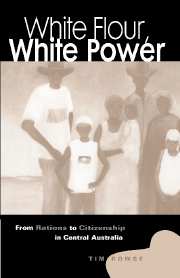10 - Alice Springs and Its Town Camps
from PART THREE
Published online by Cambridge University Press: 23 October 2009
Summary
In 1961, the chairman of the NT Housing Commission told the Employment Advisory Board that ‘occupation of a standard home would become the hallmark of an assimilated Aborigine’. To live in a standard home was to conduct oneself in a certain way. The house's internal design and equipment and its spatial relationship with other houses would reflect the norms of non-Indigenous Australian social organisation: nuclear families, whose members (the adult woman, in particular) were keen and competent users of domestic technology, materially sustained by the budgeting of a male breadwinner's income to pay for rent, water, energy, food, clothes, education – residing in streets in which there were not necessarily any links of kinship between households.
This is not the only way to imagine Indigenous ‘citizenship’ – the outcome of ‘assimilation’. Alternative specifications of ‘citizenship’ could include: a capacity to vote intelligently, to make contracts, to hold down a job (for men at least), to feel a primary loyalty to Australia, to be legally unfettered in rights to mobility and consumption. Without denying that these latter senses of citizenship were important, I will take up the remark about the ‘standard home’ because it touches on one of the abiding features of the ‘assimilation’ program in Central Australia: the social distinction between town and hinterland. I have argued that in Central Australia the rations-based apparatus of ‘assimilation’ grew out of policies to control the extent and manner of the urbanisation of Indigenous people.
- Type
- Chapter
- Information
- White Flour, White PowerFrom Rations to Citizenship in Central Australia, pp. 184 - 203Publisher: Cambridge University PressPrint publication year: 1998



